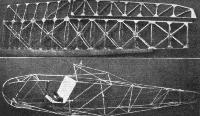
Flight, October 1930
BAKER-McMILLEN TRAINING Glider. - The wood-working firm, Baker-McMillen Co., of Akron, Ohio, are certain that the three-stage system of training, so firmly rooted in Germany, will not be adopted generally in America. They reasoned that the only real excuse for a primary type's existence was its low initial cost and maintenance, and it was concluded that an all-purpose glider could be produced which would be suitable for training the student right through into the soaring stages of his training without change. When finally additional refinement was desired, a simple change to special large span wings could be made and the student would be able to cover his entire course by the use of a single machine of moderate price, with perhaps the added cost of a pair of soaring wings in the extreme case.
Such a large order all in one machine was a new experience for Frank Gross, designer, but the "Cadet II" now stands as evidence of how well he has met requirements. It is not a primary. It is not a secondary. Neither is it a soarer, but it is all these at once, an all-purpose training glider.
Brief specification of the "Cadet II" :-
Span 37 ft. 6 in.
Length 18 ft. 9 in.
Height 4 ft. 6 in.
Weight empty 237 lb.
Weight loaded 407 lb.
Wing area (including ailerons) 162 sq. ft.
Wing loading 2-51 lb. per sq. ft.
Tailplane area 9 sq. ft.
Elevator area 8 sq. ft.
Fin area 5 sq. ft.
Rudder area 9 sq. ft.
Sinking speed 3 1/4 ft. per sec.
Gliding angle (actual) 1 in 15
- Flight, October 1930
Фотографии
-
Aeroplane Monthly 1994-11 / M.Oakey - Grapevine
The world’s oldest airworthy glider visited Lasham from the USA: Californian Jim Stoia’s 1930 Baker McMillan Cadet II.
-
Flight 1930-10 / Flight
The "Cadet II,"which combines the designer's ideas of machine to cover training and advanced soaring in one machine.
-
Flight 1930-10 / Flight
Wing and fuselage construction of the Baker-McMillen training glider "Cadet II," showing the welded steel tube construction of the latter. The wings being wood and fabric
- Фотографии


